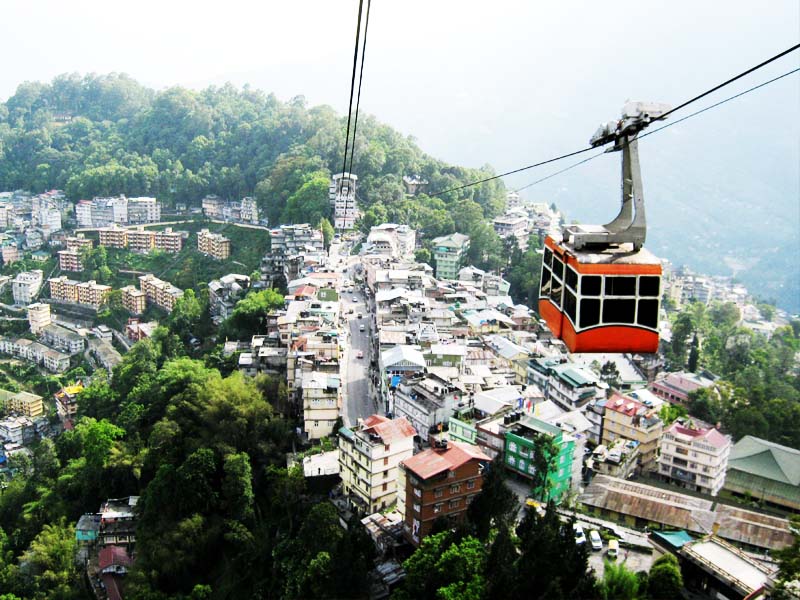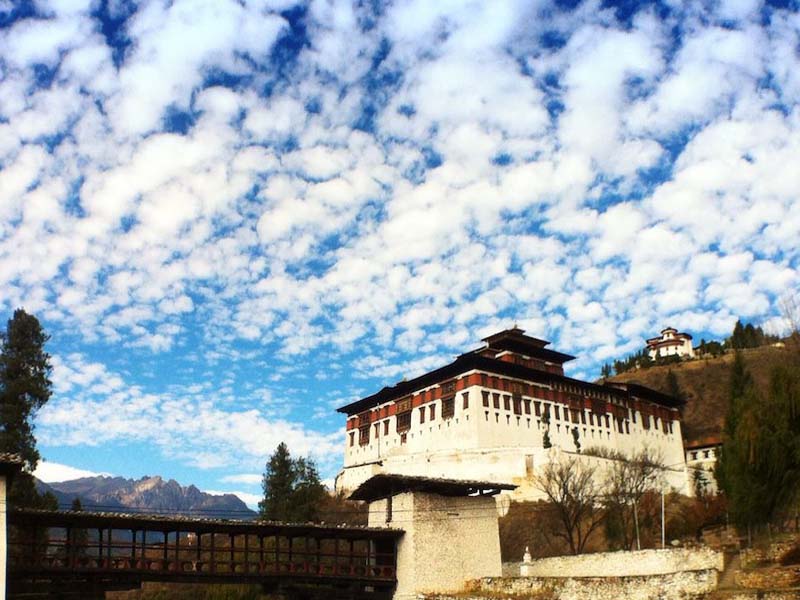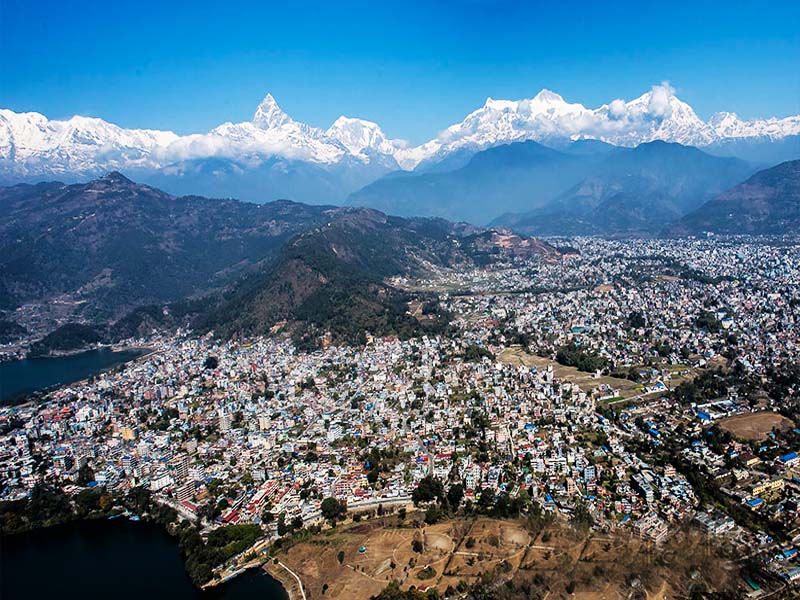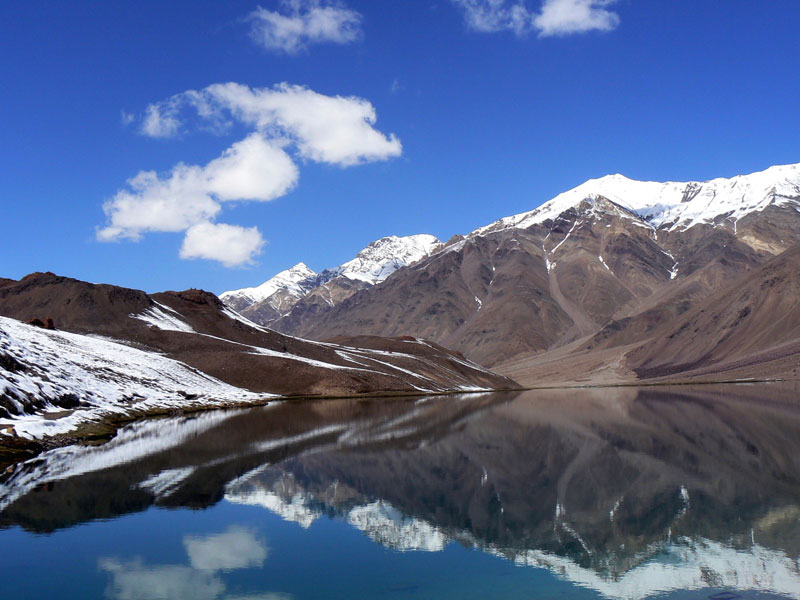DAY 01 : ARRIVE PARO
A flight into Bhutan is spectacular with views of Himalayas. Meet your Guide
and driver outside the terminal building and visit some local sightseeing in
Paro National Museum, Paro Rimpong Dzong, Kyichu temple, complex and drive
to Hotel.
Paro: Paro is one of the most beautiful valleys in the country with Bhutan’s
only airport located here, among the terraced fields, and elegant farm
houses. Willow trees line many of the roads, contrasting with bright colors
of the fields and the most popular and important sites also found within
Paro district. Paro town (2,280m) is still a small with one main street and
less than one hundred small family-run shops.
Rinpung Dzong: meaning "fortress of the heap of jewels". Built in mid 17th
century, it now serves as the administrative and judicial seat of Paro
district and residence for the 200 monks of Paro. It is also the venue for
Paro festival held in the spring. Several years ago, the colourful movie
Little Buddha was filmed here. National Museum: Established in 1967, the
museum is housed inside a circular Ta Dzong, an ancient Watch Tower. It
holds fascinating collection of arts, relics, religious thangkha paintings,
household’s stuffs, arms, handicrafts, stuffed animals and Bhutan’s famous
Stamps among others. (Open 10-4pm – closed on Monday).
Kyichu Lhakhang: Tibetan King Songtsen Gompo in the 7th century miraculously
built 108 temples, along with Jorkhang in Lhasa. Kyichu is considered to be
one of them and is one of the oldest temples in Bhutan. Overnight in Paro.
DAY 02 : PARO – HIKE TAKTSANG
Hike to Tiger’s Nest Monastery also known as Taktsang. Then visit typical
Bhutaness Farm House.
Hike to Taktsang: Drive to famed Taktsang (Tiger’s lair) monastery. Taktsang
monastery is located on the face of a 1,000m seemingly impossible sheer,
vertical cliff, above Paro valley.
The trail begins near the Satsam (2650m) and climbs steeply uphill to the
Cafeteria (2,940m), an area of exposed ridge with panoramic view of
Takstang. This takes little more than an hour. (Ponies are provided on
request to ride up till this Cafeteria, but rest of way, including return
downhill must be on foot.) You can get a good view from the Cafeteria or
hike further uphill for another hour or so to the temple itself. There are
several other temples and sites within the vicinity. Lunch is served at the
tea house. The return trek to the road head is quite steep downhill, where
you will be met by the transport.
Farm House or Village Home: Bhutanese farmhouses are colorful, decorative
and traditionally built without any nails. Majority of the houses are with
three story, first floor is utilized for sheltering cattle, second floor for
the family to live in and the top for storing and drying of foods and fodder
for animal. Almost all the farmhouses follow the same architectural pattern.
A visit to farmhouse is interesting and provides you with an experience to
the daily life of average Bhutanese.
Overnight Paro.
DAY 03 : PARO - THIMPHU
After breakfast, drive to Thimphu. In Thimphu, Visit the school of arts and
crafts, Indegenious Hospital, Folk Heritage Musuem, Textile Museum, Memorial
chorten (stupa) and handmade paper factory.
School of arts & Crafts: (open 9-5pm mon-fri and 9-1pm on Sat –with
exceptions of holidays and breaks). Commonly known as ‘the painting school’
is a national institute where children attend six-year course that provides
instruction in Bhutan’s traditional arts and crafts called Zorig Chuksum -
meaning 13 crafts
Indigenous Hospital or National Institute of Traditional Medicine (Open
9-5pm Mon-Fri, 9-1pm on Sat) is government funded institute that facilitates
research of traditional medicine and practices. It prepares and dispenses
herbal and other medicines with clinic where doctors diagnose and prescribe
traditional medicines or treatments.
Heritage Museum: Heritage Museum is also a recent addition; housed in a
traditional home displays the living style of the Bhutanese family in 19th
century. Textile Museum: A recent addition in the capital city, this museum
displays the colorful and intricately hand woven textile, both old and new.
Memorial Chorten: This landmark of Thimphu was built in 1974 in the memory
of third King, Jigme Dorji Wangchuk, who is popularly regarded as Father of
Modern Bhutan. It is a four-storey tall white building, containing statues
and iconography of deities from complex tantric teachings and serves as an
important place of worship for Thimphu residents, as well as from other
parts of the country
Paper Factory: Traditional papers were made from the daphne plant, using
simple methods. Drive from Paro to Thimphu: The distance of about 65kms from
Paro town takes little less more than 1 hours. Drive south following Pachu
river to the river confluence at Chuzom, which is also the hub of road
network going to Paro, Ha, Thimphu and Phuntsholing. From Chuzom, the drive
takes about 1 hour, staying close to the Wangchu River in the valley floor,
as you pass through villages and suburbs to the capital, Thimphu. En-route,
you can stop to view Tachogang temple and the nunnery at Sitsina.
Thimphu (2,300m): was a wooded farming valley until 1961, when it became
Bhutan's official national capital. The massive Tashicho Dzong, about 700
years old, was carefully revamped in the 1960s by the late King Jigme Dorji
Wangchuk to house the royal and main government offices. Even today, it
still only has a few streets and no traffic lights with estimated population
of 90,000 people.
DAY 04 : THIMPHU LOCAL SIGHTSEEING
This morning, drive north through the suburbs for about 40min to Dodena and
walk up to Cheri Monastery. Return to Thimphu and visit Tashichhodzong later
in the evening and some free time to browse around local shops etc
Cheri Gompa Monastery (2850m)
Cheri Gompa was first built in 1620 by shabdrung and it was here that the
central monastic body (Dratsang) was first established. Many of the
important priests of Drukpa Kagyul lineage passed periods here, and so it is
an important ilgrim site for Bhutanese. Druing the weekends, many Bhutanese
are seen climbing up the hill from Dodena (2,600m), where the road ends.
Cross a wooden cantilever bridge and climb up the hill with moss-laden pine,
fir and rhododendron trees, that takes little over 1 hour. Return to the
road.
Instead of walking uphill from Dodena, one can make it more interesting by
starting the walk from pangri Zampa. Drive towards northern end of the
valley for about 1 ½ hr and start an exciting walk to Cheri Monastery. This
is a 2-3 hour pleasant rural walk, gently up a valley through paddy fields
and woodland via Tibetan village, following the Wanchu river-upstream till
Dodena. Then walk uphill to Cheri Gompa. Return downhill, meet the transport
and drive to Thimphu.
Tashichhodzong: This fortress serves as the office of the King, ministers
and various government organizations. It also is the headquarters for
central monastic body of Bhutan. Bhutan's spiritual leader Je-Khenpo and the
monks of both Thimphu and Punakha reside here during summer. It is also the
venue for Thimphu Festival in the autumn season. Overnight Thimphu.
DAY 05 : THIMPHU - PUNAKHA / WANGDUEPHODRANG
Drive from Thimphu to Punakha: The drive from Thimphu (75Kms) takes about 3
hours. The road climbs from Thimphu to Dochula Pass (3050m) and descends
through ever changing forests into semi-tropical valley of Punakha at around
1250m.
En-route stop at dochula Pass(3050m) where you can view the estern
Himalayas, including Bhutan’s higest mountain, Gangkhar Punsum(7550m).
Punakha Dzong: or Pungthang Dechen Phodrang "Palace of Great Happiness” is
located on the confluence of two rivers, the Pho and Mochu. It was built in
1637 by Shubdrung Nawang Namgyal and following the ancient traditions, it
serves as winter residence for chief abbot (Je-khenpo) and the monks of
Central Monastic Body, who return to Thimphu in the summer.
Punakha and Wangdue, although two separate districts, are located in one
valley (20km or ½ hr drive apart) Overnight Punakha. Sightseeing includes
Khumsum Yuelley Chorten (Stupa) and Chimi Lhakhang Wangduephodrang Dzong.
Chimi Lhakhang: a monastery and fertility temple dedicated to Lama Drukpa
Kuenley, a Tibetan Buddhist saint known popularly as “the divine madman” and
considered a folk hero in Bhutan for his unconventional ways. Drukpa Kuenley
originally built a chorten on the site in the 14th century, on which a
temple was later built in 15th century. The temple, flanked by nearly 100
tall prayer flags, sits atop a picturesque hill. It has long been a
pilgrimage site for childless couples. This easy walk takes about ½ hour
each way.
Punakha and Wangdiphodrang: Punakha and Wangdue, although two separate
districts, are located in one valley (20km/ ½ hr drive apart) and they are
at the lower elevation of about 1,250m with pleasant winters. Cactuses,
Oranges, bananas and sub-tropical plants are found here. Punakha was once
the winter capital of Bhutan, the tradition that is still held by the
Central Monastic body.
Wangdiphodrang Dzong: Shubdrung Nawang Namgyal in 1638 had built this
massive fortress sitting on a hilltop at the confluence of Punakha Chu and
Tang Chu Rivers. It is built in the shape of a sleeping bull. Wangdi
festival is celebrated here in every autumn season for three days. Overnight
in Punakha/Wangduephodrang.
DAY 06 : PUNAKHA / WANGDUEPHODRANG - PARO
Sightseeing around Punakha. Hike to Khamsum Yuelley and drive back to Paro
via Thimphu. Local sightseeing in Thimphu Weekend market.
Khamsum Yuelley: Drive to the idyllic countryside north of Punakha to the
village of Nezigang, starting point for our gradual hiking ascent through
cultivated fields and little hamlets to the Khamsum Yuley Namgay Chorten, a
shrine recently built by the royal family. The shrine is an amazingly
elaborate structure with a rainbow of Guru Rimpoche images and superb views
of the Punakha Valley. The hike uphill takes about 1 hour and you can return
via different route following ancient riverside trails amid whitewashed
farmhouses to Punakha Dzong.
Drive from Punakha/Wangduephodrang to Paro: The drive from Punakha to Paro
via Thimphu takes about 5 hours, covering total of 135 Km. From Punakha,
climb back to the Dochula Pass(3,050m), where you have another opportunity
to view the peaks of the eastern Himalayas. Cescend to Thimphu from Dochula
takes about 40 Minutes. After lunch at Thimphu,Drive west to Paro. The
western branch of lateral highway from Thimphu, runs close to the Wangchu
river in the valley floor, through the suburbs and villages of Thimphuto
arrive at the river confluence of Chuzom, which is also the hub of road
network going to Paro, Haa, Thimphu and Phuntsholing. From Chuzom, it is
North West for about an ½ hour, following Pa Chu river upstream, passing
Tachogang temple on the other side of river, then through relatively
straight road, into the villages and farm houses of Paro valley. Overnight
in Paro.
DAY 07 : PARO DEPARTURE
After breakfast, transfer to the airport in time for your departure.





